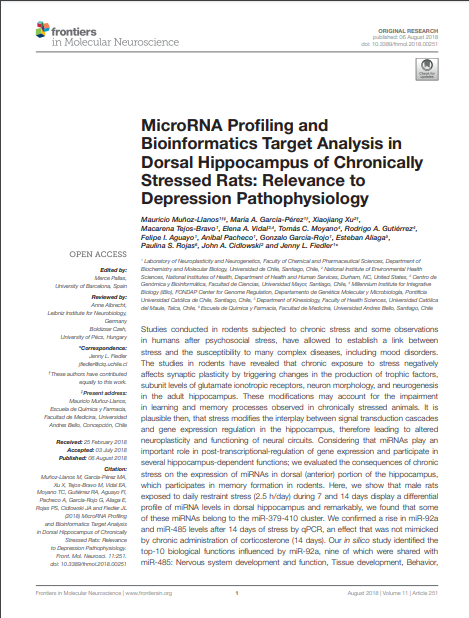MicroRNA Profiling and Bioinformatics Target Analysis in Dorsal Hippocampus of Chronically Stressed Rats: Relevance to Depression Pathophysiology

Fecha
2018Autor
Vidal, Elena A. [Univ Mayor, Fac Ciencias, Ctr Genom & Bioinformat, Santiago, Chile]
Muñoz-Llanos, Mauricio
García-Pérez, María A.
Xu, Xiaojiang
Tejos-Bravo, Macarena
Moyano, Tomás C.
Gutiérrez, Rodrigo A.
Aguayo, Felipe I.
Pacheco, Anibal
García-Rojo, Gonzalo
Aliaga, Esteban
Rojas, Paulina S.
Cidlowski, John A.
Fiedler, Jenny L.
Ubicación geográfica
Notas
HERRAMIENTAS
Acceda a títulos restringidos
¿Cómo descargar?Resumen
Studies conducted in rodents subjected to chronic stress and some observations in humans after psychosocial stress, have allowed to establish a link between stress and the susceptibility to many complex diseases, including mood disorders. The studies in rodents have revealed that chronic exposure to stress negatively affects synaptic plasticity by triggering changes in the production of trophic factors, subunit levels of glutamate ionotropic receptors, neuron morphology, and neurogenesis in the adult hippocampus. These modifications may account for the impairment in learning and memory processes observed in chronically stressed animals. It is plausible then, that stress modifies the interplay between signal transduction cascades and gene expression regulation in the hippocampus, therefore leading to altered neuroplasticity and functioning of neural circuits. Considering that miRNAs play an important role in post-transcriptional-regulation of gene expression and participate in several hippocampus-dependent functions; we evaluated the consequences of chronic stress on the expression of miRNAs in dorsal (anterior) portion of the hippocampus, which participates in memory formation in rodents. Here, we show that male rats exposed to daily restraint stress (2.5 h/day) during 7 and 14 days display a differential profile of miRNA levels in dorsal hippocampus and remarkably, we found that some of these miRNAs belong to the miR-379-410 cluster. We confirmed a rise in miR-92a and miR-485 levels after 14 days of stress by qPCR, an effect that was not mimicked by chronic administration of corticosterone (14 days). Our in silico study identified the top-10 biological functions influenced by miR-92a, nine of which were shared with miR-485: Nervous system development and function, Tissue development, Behavior, Embryonic development, Organ development, Organismal development, Organismal survival, Tissue morphology, and Organ morphology. Furthermore, our in silico study provided a landscape of potential miRNA-92a and miR-485 targets, along with relevant canonical pathways related to axonal guidance signaling and cAMP signaling, which may influence the functioning of several neuroplastic substrates in dorsal hippocampus. Additionally, the combined effect of miR-92a and miR-485 on transcription factors, along with histone-modifying enzymes, may have a functional relevance by producing changes in gene regulatory networks that modify the neuroplastic capacity of the adult dorsal hippocampus under stress.
Coleccion/es a la/s que pertenece:
Si usted es autor(a) de este documento y NO desea que su publicación tenga acceso público en este repositorio, por favor complete el formulario aquí.